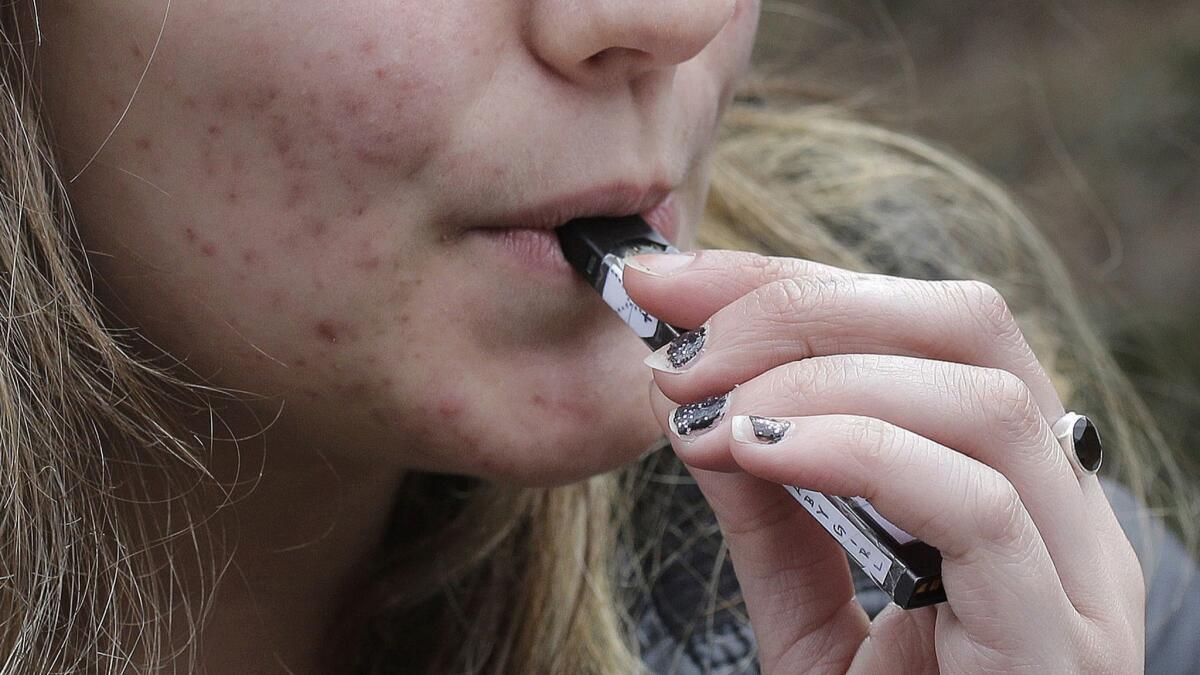Seeing teen vaping as an addiction, schools move toward treatment model

- Share via
Reporting from Hartford, Conn. — A glimpse of student athletes in peak physical condition vaping just moments after competing in a football game led Stamford High School Principal Raymond Manka to reconsider his approach to the epidemic.
His school traditionally has emphasized discipline for those caught with e-cigarettes. Punishments become increasingly severe with each offense, from in-school suspensions to out-of-school suspensions and, eventually, notification of law enforcement.
But Manka began thinking about it more as an addiction problem, and less of a behavior issue, after seeing the two players from another school vaping near their bus. “It broke my heart,” said Manka, whose school is now exploring how to offer cessation programs for students caught vaping or with vaping paraphernalia.
“We’ve got to figure out how we can help these kids wean away from bad habits that might hurt their body or their mind or otherwise create behaviors that can create habits that will be harmful for the remainder of their lives,” he said.
Schools elsewhere have been wrestling with how to balance discipline with prevention and treatment in their response to the soaring numbers of vaping students.
Using e-cigarettes, often called vaping, has now overtaken smoking traditional cigarettes in popularity among students, says the Centers for Disease Control and Prevention. Last year, one in five U.S. high school students reported vaping the previous month, according to a CDC survey.
E-cigarettes produce an aerosol by heating a liquid that usually contains high levels of nicotine — the addictive drug in regular cigarettes and other tobacco products — flavorings and other chemicals. Users inhale this aerosol into their lungs; when they exhale, bystanders often breathe it in too.
Compared with regular cigarettes, the research on the health effects of e-cigarettes is painfully thin. Experts say that although using e-cigarettes appears less harmful over the long run than smoking regular cigarettes, that doesn’t mean they’re safe — particularly for youth, young adults, pregnant women or adults who do not currently use tobacco products.
“Studies have shown that e-cigarette use among young people is potentially associated with an increased risk of progressing on to cigarette use and to vaping cannabis, which has become increasingly common in recent years,” said Dr. Renee Goodwin, a researcher and professor of epidemiology at the City University of New York and Columbia University who studies tobacco and cannabis use.
Besides nicotine, e-cigarettes can include other harmful substances, including heavy metals like lead and cancer-causing agents. The vaping liquid is often offered in a variety of flavors that appeal to youth and is packaged in a way that makes them attractive to children. And the long-term health effects, Goodwin noted, are unknown.
Experts say the CDC classifies e-cigarettes as a tobacco product, and many schools lump vaping in with tobacco use in applying codes of conduct, treating offenses similarly.
In Connecticut alone, administrators dealt with 2,160 incidents in which students were caught vaping or with vaping paraphernalia in violation of school policies during the 2017-18 school year, up from 349 two years earlier.
Nationwide, some schools have removed bathroom stall doors or placed monitors outside of restrooms to check students in and out. Others have installed humidity detectors that sound an alarm when vapor clouds are detected.
Lawmakers are beginning to show similar concerns. Oklahoma has passed legislation to ban vaping on school property, and a dozen states have passed legislation to increase the age for smoking and vaping to 21.
Nevertheless, some school districts have begun taking a more comprehensive approach by emphasizing treatment and prevention.
“The schools that seem to be most effective are those that are of course enforcing their disciplinary code — they can’t do otherwise — but are using that as the floor and not the ceiling,” said Bob Farrace, a spokesman for the National Association of Secondary School Principals.
Thomas Aberli, the principal at Atherton High School in Louisville, Kentucky, said it began an intensive anti-vaping education program this year with the help of the American Association of Pediatrics. Teaching teens about how vaping companies have been courting them with flavored products seems to be having an effect.
“You could tell how angry they were getting with this sense of manipulation,” he said. “That was really a turning point for us in knowing the best way to approach this problem.”
More to Read
Sign up for Essential California
The most important California stories and recommendations in your inbox every morning.
You may occasionally receive promotional content from the Los Angeles Times.










